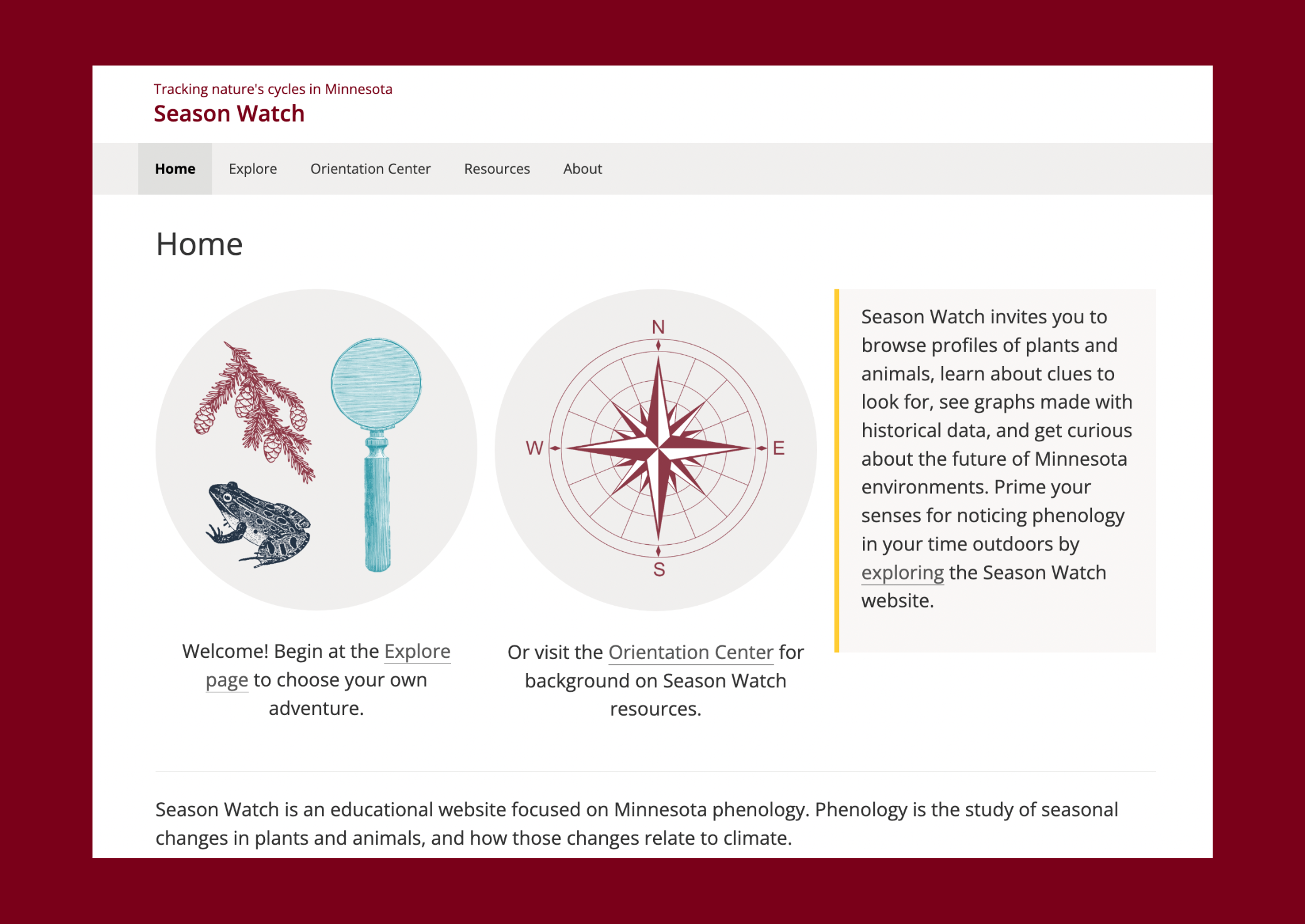
The Season Watch homepage (seasonwatch.umn.edu).
There’s an eye-opening sensation one feels when finally learning the name of a familiar concept. It goes something like, “Ah! So that’s what that’s called! Have people been talking about this all along? Now I can join the conversation.” For many people, even folks trained in biology, “phenology” is one of those words.
Phenology is the study of annual cycles in living things, and how those cycles relate to weather and climate – a deceptively simple summary for an area of knowledge that is fundamental to life, complex in its detail, and expansive in its significance. Phenology is also part of our everyday experiences. As such, it appeals to many, including educators, as an accessible form of science that is directly observable (meaning students can get hands-on involvement), place-based (and yet everywhere, so no one is excluded from engaging with it), and globally important.
The many facets of phenology were the inspiration for the team behind Season Watch, a new educational website built collaboratively by staff in the University’s Department of Forest Resources and at Northern Community Radio KAXE/KBXE, with funding provided by the Minnesota Environment and Natural Resources Trust Fund and design elements contributed by Backyard Phenology. Designed for exploring, Season Watch aims to connect users with Minnesota’s cycles of nature. In doing so, it invites them to cross the threshold from not knowing what phenology is, to engaging with it confidently – and, hopefully, to caring more deeply for the natural world around them.
Season Watch introduction video.
Phenology is much more than a learning activity, though; it is also used by people working with natural resources in countless ways. That’s because it is at work at every level of living systems, influencing whether populations persist, or if linkages between organisms continue to hold. Consider the timing of invasive plant management, for example. If we remove invasive plants once they have set seed, we risk spreading them; on the other hand, removing them during flowering reduces the risk of spread. And how come it’s important to plant tree seedlings in spring? Well, it’s because they require adequate time to establish themselves before they can survive the stresses of winter.
In the era of climate change, phenology is even more important as plant life cycles shift in response to warmer winters and hotter, drier summers. As such, phenology is an indispensable area of knowledge for a sustainable future.
Season Watch doesn’t go in depth into phenology research but instead aims to establish foundational awareness of phenology, thereby preparing the next generation of Minnesotans to think and care about different living systems. To do so, the website presents users with different ways to explore examples of phenology, encouraging them to forge their own pathways toward understanding its relevance.
Season Watch website: A Tour video.
Head to the Season Watch website and you’ll find a menu of accessible, intuitive entry points for visitors to explore the lives of plants and animals in whatever ways are most interesting to them. One entry point is “times of the year,” which shares specific phenological clues that nature-watchers can anticipate throughout the year. Another page on “state symbols” (such as the loon and the walleye) appeals to Minnesotans’ state pride. And the “stories of noticing” page helps visitors get comfortable making the leap from “I’m just watching nature,” to “I’m doing phenology,” by modeling note-taking and data collection.
In addition, 76 profiles on a variety of taxa (mostly plants and animals) contain a total of 135 graphs. These graphs visualize phenology data collected in Minnesota over the past fifty years. At a glance, you can review 50 years of flowering data from Ramsey County on elms, or 33 datapoints from Sherburne County on sandhill crane arrival, or 14 years of data from Hubbard County on cicadas buzzing. Because not all visitors are fluent with technical figures, handy links point to information on reading graphs; who collected the data and how; and how to download datasets for independent exploration. Through self-guided inquiry, Season Watch visitors are invited to get curious about what the data mean.
Phenology is a science, yes, but it is also a world of ever-changing phenomena that can be accessed in multiple ways. Noticing the first crocus in spring can delight us, get us talking to one another, and enrich our sense of place. It can even result in a memory one revisits each spring, a touchstone that helps one understand time as something that is at once cyclical and made up of instants. The Season Watch website does not shy away from such meaning-making experiences or considering phenology from unexpected, non-scientific points of view. After all, a haiku poem on crocus blooms or a garden meditation could be an unexpected doorway that lets someone in on the meaning and wonder of phenology.
~ Story by Abbie Anderson, Season Watch researcher and program coordinator, University of Minnesota Department of Forest Resources
About Season Watch
Season Watch was built to support science learning, literacy, and inquiry for all curious about seasonal change in nature. In addition to the website, the Season Watch team also runs a series of educator workshops and will soon be publishing podcasts.
